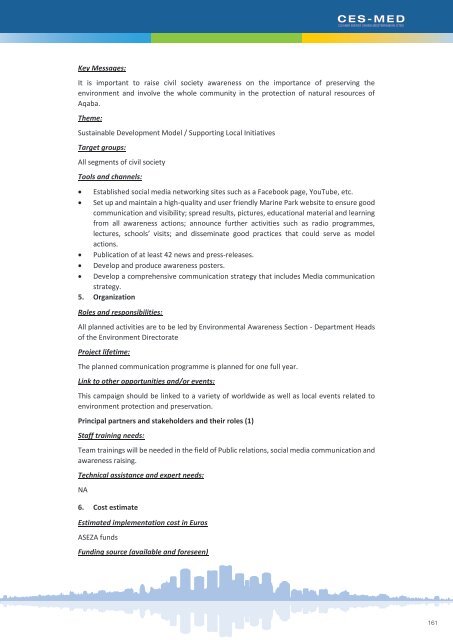161117_Jordan_ASEZA_SECAP_Revised
You also want an ePaper? Increase the reach of your titles
YUMPU automatically turns print PDFs into web optimized ePapers that Google loves.
sometimes burnt and sometimes left without burning. Within the last few years, waste scavengers returned to the site and dug<br />
up some of this old waste to collect recyclables and left the site’s soil cover disturbed and the old waste exposed. The current<br />
landfill is almost full loaded and should be closed as soon as possible.<br />
Current waste recycling practices at the Active Landfill site consist of contracted labourers picking recyclables directly from the<br />
freshly dumped waste on the active working face of the landfill before it gets compacted and covered. This is not an acceptable<br />
or efficient method for recycling. This practice also poses potential health and safety risks for workers, such as exposure to<br />
contaminants, contact with vectors, and personal injury. Waste is also typically left uncovered and uncompacted, which is<br />
prohibited by Regulation No.27 for 2005.<br />
The primary challenge concerning the Aqaba site is to develop an integrated solid waste management plan, consisting of a<br />
waste segregation/treatment facility and a properly engineered sanitary landfill.<br />
Technical Background<br />
This design report for Aqaba landfill prepared for USAID addresses the following components:<br />
1. Access control for site;<br />
2. Material Recovery Area to replace current waste scavenging practices;<br />
3. Re-utilization of existing waste/burnt waste/soil mass to allow for stabilization of existing in-place waste;<br />
4. Design of individual landfill cells with the bottom of each cell sloping towards leachate collection system;<br />
5. Design of a base geosynthetic liner to prevent liquids collected from entering subsurface soils and regional groundwater;<br />
6. Design of leachate collection, conveyance and storage/treatment system;<br />
7. Design of final grading plan to allow surface water drainage;<br />
8. Design of final cap and storm water management system;<br />
9. Design of landfill gas management system (maximum annual generating capacity is 6.053 MWh). The gas management<br />
system will minimize potential landfill fires and control landfill gas migration by installing landfill gas wells and collecting<br />
pipes and excavate and utilize existing burnt waste/soil mix as daily cover material.<br />
The targeted minimum airspace for the Aqaba Landfill is to provide for 20 years of waste disposal for the population of Aqaba.<br />
The incoming waste is expected to be about 0.95 kg/person-day, according to the “Country Report on the Solid Waste<br />
Management in <strong>Jordan</strong>” prepared by SWEEP-Net (2012).<br />
Based on the USAID report, the maximum annual gas generation rate was estimated as 12.73 m 3 /min. Considering a<br />
conservative 50% system efficiency for the purposes of estimating power generation potential, the maximum gas collection<br />
rate is estimated at approximately 6.36 m 3 /min near the end of the landfill active life. This corresponds to the maximum annual<br />
generating capacity of 691 kW (6.05 GWh). Calculations indicate that a 250 to 300 kW electric generator could be installed at<br />
year 7 and another identical one could be added at year 16.<br />
In the Baseline year, the reference emissions were calculated to be 30,717.48 tn CO 2 eq, according to the following equation<br />
(see BEI section).<br />
Methane emissions (Gg/yr)=(MSWt*MSWf*MCF*DOC*DOCf*F*16/12-R)*(1-OX)<br />
Since the methane gas (symbolized as F in the equation above) to be collected at an annual basis is considered to be half of that<br />
generated, the emission reductions based on the BEI calculations will be cut in half, considering that the rest of the parameters<br />
remain the same. Thus they will be reduced by 15,358.74 tn CO 2 eq at an annual basis. It should be noted that the above<br />
approach is the simplified method for the calculation of emissions, and if additional gases should be considered besides<br />
methane, other approaches should be followed. Also, it is highlighted that the BEI data and not the BAU estimations have been<br />
utilized, since the landfill is expected to close before 2030, but remain operational as far as the electricity generation is<br />
concerned till then.<br />
Finally, emission reductions from the biogas generated electricity that substitutes fossil fuel generated electricity should be also<br />
taken into consideration. These are estimated to be 3,510.74 tn CO 2, if the EF of 0.58 is used.<br />
146

















